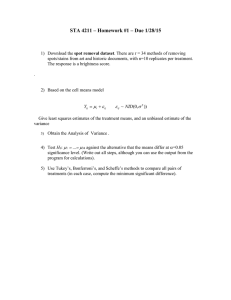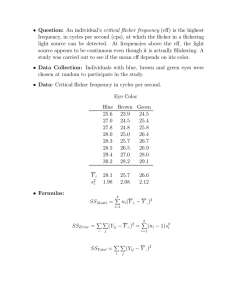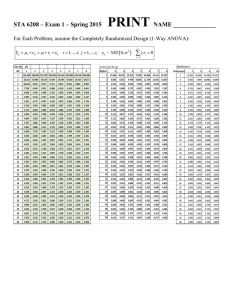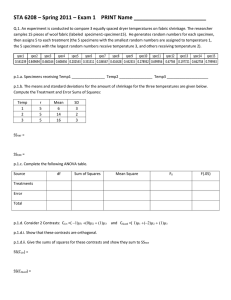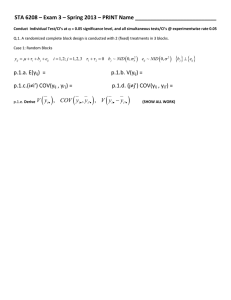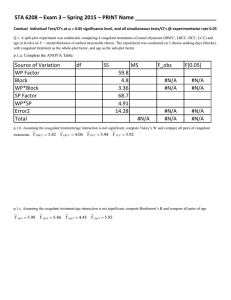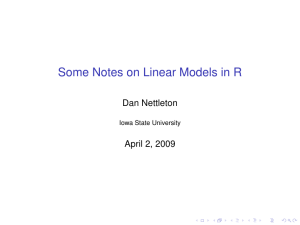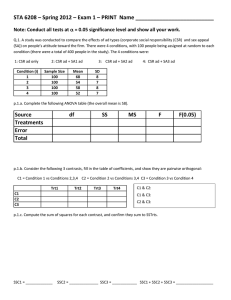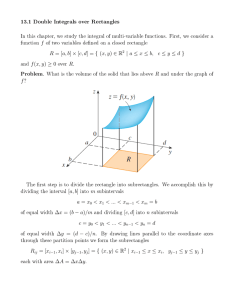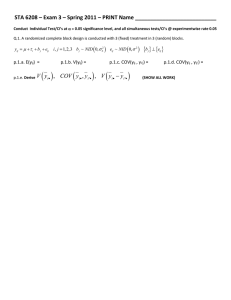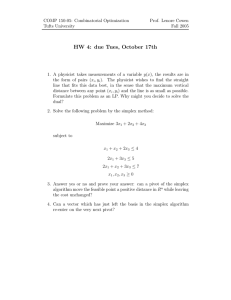STA 6208 – Exam 3 – Spring 2012 – PRINT...
advertisement
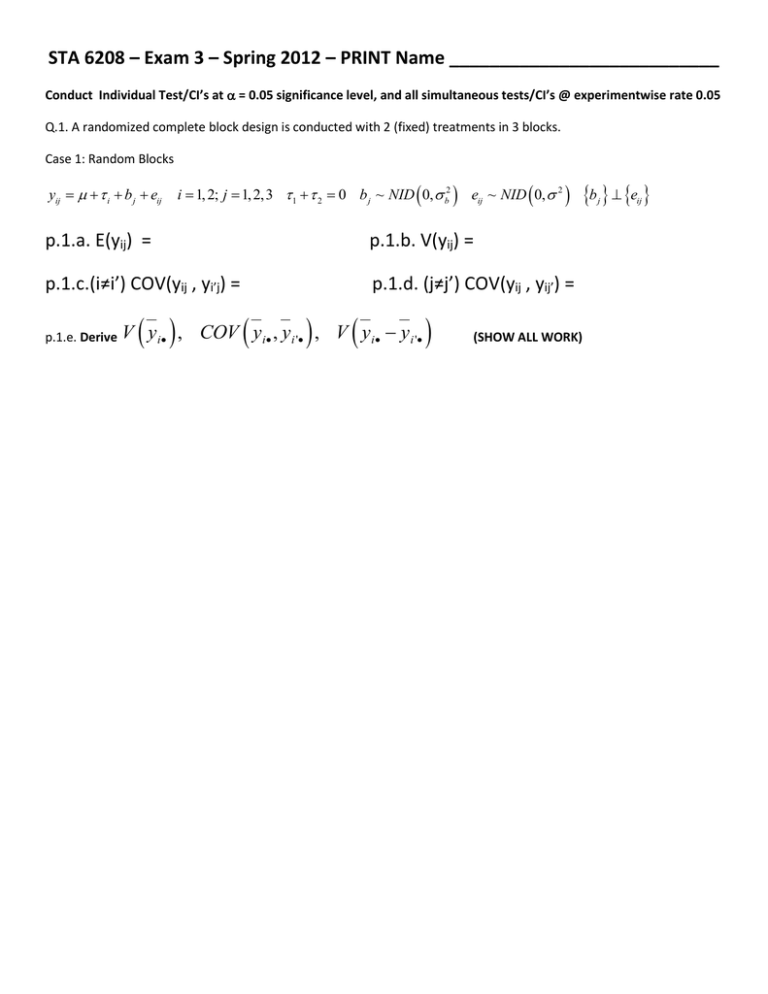
STA 6208 – Exam 3 – Spring 2012 – PRINT Name ___________________________ Conduct Individual Test/CI’s at = 0.05 significance level, and all simultaneous tests/CI’s @ experimentwise rate 0.05 Q.1. A randomized complete block design is conducted with 2 (fixed) treatments in 3 blocks. Case 1: Random Blocks yij i b j eij i 1, 2; j 1, 2,3 1 2 0 b j ~ NID 0, b2 eij ~ NID 0, 2 b e p.1.a. E(yij) = p.1.b. V(yij) = p.1.c.(i≠i’) COV(yij , yi’j) = p.1.d. (j≠j’) COV(yij , yij’) = p.1.e. Derive V y i , COV y i , y i ' , V y i y i ' (SHOW ALL WORK) j ij Case 2: Fixed Blocks yij i j eij i 1, 2; j 1, 2,3 1 2 0 1 2 3 0 eij ~ NID 0, 2 p.1.f. E(yij) = p.1.g. V(yij) = p.1.h. (i≠i’) COV(yij , yi’j) = p.1.j. Derive V y , i p.1.i. (j≠j’) COV(yij , yij’) = COV y i , y i ' , V y i y i ' (SHOW ALL WORK) Q.2. Authors of an academic research paper report that they conducted a randomized block design, with 3 treatments and 8 blocks. They report that the Bonferroni Minimum Significant Difference for comparing pairs of treatment means is B = 12.0. What is the Mean Square Error from their Analysis of Variance? Q.3. A split-plot experiment is conducted to compare 5 cooking conditions (combinations of temperature/time) and 8 recipes for quality of taste of cupcakes. Because of the logistics of the experiment, each of the 5 cooking conditions can be conducted once per day (in random order). The recipes are randomly assigned to the slots in the oven (each recipe is observed once in each cooking condition). The experiment is conducted on 3 different days (blocks). Give the Analysis of Variance (sources and degrees of freedom and critical F-values), assuming no interaction between blocks and subplot units. The response is an average taste rating among a panel of judges. Source Whole Plot Factor Blocks Error1 Sub Plot Factor WP*SP Interaction Error2 Total Label df Error df F(.05) #N/A #N/A #N/A #N/A #N/A #N/A #N/A #N/A Q.4. A latin-square design is used to compare 6 brands of energy enhancing drinks on alertness, measured by the amount of items completed in a fixed amount of time on skills tests. There are 6 different skills tests, and 6 participants, such that each energy drink is observed once on each skills test and once for each participant. The drink means and partial ANOVA table are given below. p.4.a. Complete the tables. Mean SS Drink1 30 Source Energy Drink Skills Test Participant Error Total Drink2 50 df Drink3 36 SS Drink4 42 Drink5 44 MS Drink6 38 F Overall 40 F(.05) 460 2000 4600 p.4.b. Compute Tukey’s HSD and Bonferroni’s MSD for comparing all pairs of drinks. Tukey’s HSD: ______________________________ Bonferroni’s MSD __________________________________ Q.5. A 23 factorial experiment is conducted to determine the main effects and interactions among 3 factors (presence/absence) on taste quality for frozen dinners. The following table gives the design, mean, and standard deviation (SD) for the 8 combinations of factor levels. There were 3 replicates per treatment. Trt (1) a b c ab ac bc abc A -1 1 -1 -1 1 1 -1 1 B -1 -1 1 -1 1 -1 1 1 C -1 -1 -1 1 -1 1 1 1 AB 1 -1 -1 1 1 -1 -1 1 AC 1 -1 1 -1 -1 1 -1 1 BC 1 1 -1 -1 -1 -1 1 1 ABC Mean 36 64 28 32 68 72 24 76 SD 4 3 3 2 1 2 3 3 p.5.a. Give the +1/-1 levels for the ABC Interaction in the table above. p.5.b. Compute MSE p.5.c. Compute l A lA = _____________ n k y , i 1 i i SSA r 2 l n A 2 where ki 1 Test H0: No Factor A effect SSA = _________________ Test Statistic = _________________ Rejection Region: __________ Q.6. A Repeated measures design is used to test for effects among 3 treatments at 2 points in time. A sample of 30 subjects is selected, and assigned at random so that 10 subjects receive Trt A, 10 receive Trt B, and 10 receive Trt C. The (univariate) model fit is: yijk i d k (i ) j ij eijk i 1, 2,3 The subject within treatment sum of squares is: SS Subject(Trt) 2 y 3 10 i 1 k 1 The table of treatment/time means is: Trt\Time 1 2 3 1 50 40 60 j 1, 2 k 1,...,10 i k y i 2 4000 2 70 60 80 p.6.a. Complete the following ANOVA table with corrected total sum of squares = 20,000 Source Treatments Subject(Trts) Time Trt*Time Error Total df SS MS F F(.05) p.6.b. Compute Tukey’s HSD and Bonferroni’s MSD for comparing pairs of treatment means Tukey’s W = _______________________________ Bonferroni’s B = ______________________________ Q.7. Jack and Jill each fit an Analysis of Covariance, relating post-trt score (Y) to treatment and pre-trt score (X). The overall pre-treatment mean score is x 25 and there are r=5 subjects per treatment and no interaction. Jack’s Model: yij i xij x eij i 1, 2,3 Jill’s Model: yij 0 1 xij 1 z1 2 z2 eij Jack's Beta 59.20 1 54.83 2 48.57 3 0.33 Trt y-bar x-bar 1 58.38 22.5 Jill's Beta 40.28 0.33 10.64 6.27 2 54.83 25 j 1,...,5 1 if i 1 1 if i 2 z1 z2 0 otherwise 0 otherwise 0 1 1 2 3 overall 49.40 54.20 27.5 25 p.7.a. Show how Jack uses his model to obtain an estimate of Jill’s 01 p.7.b. Show how Jill uses her model to obtain an estimate of Jack’s 3 p.7.c. Compute the adjusted means for each treatment. Trt 1 _________________________ Trt 2 __________________________ Trt 3 ___________________________
